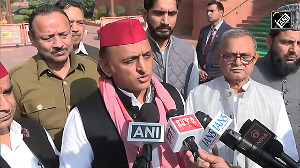Articulate segments of Muzaffarpur have been at the the forefront of all anti-establishment mobilisation, which makes their silence over the atrocities in a shelter home in the town puzzling.
Could it be that if those accused of horrific crimes belong to dominant castes and if the victims belong to the vulnerable groups, then the middle classes become mute, asks Mohammad Sajjad.
Illustration: Dominic Xavier/Rediff.com.

Muzaffarpur in north Bihar has been shamed after it came to light that over three dozen hapless girls were subjected to sexual depredation and unspeakable brutality in a state government-funded shelter home in the town.
Patna-based journalist Santosh has been pursuing the issue since February 2018 when a team from the Tata Institute of Social Sciences, Mumbai, submitted its social audit report indicting such institutions across Bihar.
The government and the Opposition had no compunction in sitting over the report for more than two months.
The sub-regional editions of various Hindi newspapers published in Muzaffarpur have revealed horrific details pertaining to this scandal since early June.
The man at the heart of this scandal, Brajesh Thakur, owns three newspapers -- Pratah Kamal (Hindi; founded in 1982 by his father Radha Mohan Thakur), Halaat-e-Bihar (Urdu), and News Next (English).
He gets almost Rs 1 crore (Rs 10 million) a year from the Bihar government for the 17 NGOs he runs.
His proposal for a fifth shelter home (this one for beggars, in Patna) was approved by the Bihar government on May 31, 2018, despite the TISS report of February 2018 exposing him.
During my long telephonic conversation with Santosh, who had also filed a Public Interest Litigation in the Patna high court, he shared his agony over all political formations maintaining a questionable silence for weeks.
The advocate general of Bihar, arguing before the high court, had the temerity to call people like him the 'ugly face of society' for which the judge, Santosh shared, reprimanded the government pleader and asked how could the ones exposing misdeeds become the ugly face.
Sadly, the Patna-based print media and the Delhi-based print and electronic media took long to take up the subject.
Muzaffarpur-based journalist Gulshad Ahmad of the Dainik Bhaskar shared his anguish with me on the phone, saying that for the national media this horrific tale became worth their while only after he and his colleagues in Muzaffarpur and Patna unearthed the possibility that some girls may have been killed at the shelter home and their dead bodies could be found buried in the premises of the residence cum office of the chief accused, Brajesh Thakur.
Only after this did the OB vans of various news television channels land in Muzaffarpur in late July to cover the search for the dead bodies.
Gulshad complained that neither the government and Opposition nor the national media is working hard to unearth the sordid scandal, which could well be much bigger than the Srijan scam under the Nitish Kumar-led government.
Brajesh Thakur's network is said to be deeply entrenched into each segment of power. He has a longstanding political association with Anand Mohan Singh, who symbolises Rajput power in Bihar and who was convicted in the lynching of G Krishnaiah, a young IAS officer who was district magistrate of Gopalganj in 1994.
Anand Mohan Singh had also led the funeral procession of Chhotan Shukla, the slain Bhumihar gangster cum transport entrepreneur from Muzaffarpur-Vaishali.
In Bihar, the 1990s was an era of wars between gangster-politicians from the backward castes, and the Bhumihars and Rajputs. Hemant Shahi, an MLA and son of party stalwart L P Shahi, was killed inside the deputy collector's office, followed by the killing of Chhotan Shukla.
In the wake of this violence, Bhumihar-Rajput unity was forged on the initiative of Anand Mohan Singh, whose wife won the Vaishali Lok Sabha by-election in 1994 defeating Lalu Yadav's nominee.
Until then, the two dominant castes were supposed to be rivals of, and competitive with, each other in Bihar politics.
Subsequently, gangster-politician and minister in the then Rabri Devi cabinet, Brij Bihari, was killed in June 1998, allegedly by Munna (Vijay) Shukla to avenge his elder brother's killing. Bihari's widow Rama Devi, the current BJP MP from Sheohar, started her political career with the RJD.
Brij Bihari symbolised the assertion of backward castes in Muzaffarpur and adjoining districts. An engineer by profession, he started his career in the 1980s under the patronage of Congress politician and the Bhumihar strongman of Muzaffarpur, Raghunath Pandey.
There could be many more Brajesh Thakurs across Bihar, running such NGOs and media firms, and fattening themselves on government money, with deeply entrenched clout in politics, the bureaucracy and the media.
Local journalists, who have exposed all these matters, live under implicit and explicit threats and intimidation, which cannot be taken lightly given the reach of the accused.
As compared to them, Delhi-based journalists working for large big media houses may not be as vulnerable as their local counterparts in Muzaffarpur and Patna.
Muzaffarpur's claim to fame is litchi fruit. Muzaffarpur has also been (in)famous for its 'red-light' area, Chaturbhuj Asthan.
Such an image was rectified by the brave, brilliant, work of a litterateur-academic at Delhi University, Prabhat Ranjan, who belongs to Muzaffarpur. He wrote Kottha Goyee: Chaturbhuj Asthan Ke Qissey (in Hindi and Urdu), and brought out the stories of some creative geniuses who were accomplished in music, dance, and other such pursuits.
In politics, even during the era of Congress hegemony in the early decades after India's Independence, Muzaffarpur did have space for Socialist, Left-leaning, and 'ultra' Left radicalism for rural reconstruction, challenging the feudal upper caste hegemony.
Besides the social revolution launched by the Buddha and Mahavir in Vaishali in the 6th century BC, this region demonstrated its presence in the movement of 1857.
With Gandhiji's arrival in Muzaffarpur in April 1917 for the Champaran Satyagraha, it joined the ongoing national movement. In 1908, Khudiram Bose and Prafulla Chaki resorted to violent revolution against the British Raj and embraced their death.
Muzaffarpur elected Socialist stalwarts like Acharya J B Kripalani and Ashoka Mehta. In my book on 19th-20th century Muzaffarpur, I explored and articulated all these details. It has left me wondering why the citizens of Muzaffarpur did not vent their anger and register their protests at the shelter home horrors by coming out on streets in large numbers?
After discussions with locals, I could somehow make out that the suffering girls who were subjected to rape and brutalities for years, don't have parents and hence their caste identities perhaps cannot be determined.
India being a deeply caste-based society, invariably shows its concerns mostly in terms of caste/religion-based identities.
Here, there are no specific caste groups to demonstrate solidarity with the hapless victims.
Another possible explanation for the lack of mass protests against this horrific brutality could be the fact that at least in the case of the Balika Griha (Muzaffarpur), the chief accused Brajesh Thakur belongs to a most dominant caste of Bihar, Bhumihar-Brahman.
Muzaffarpur is supposed to be the 'capital' of the Bhumihars.
In all spheres of power -- politics, education, crime, the bureaucracy, the media, trade, real estate -- the Bhumihars are supposed to be the most dominant community, at least in Muzaffarpur.
So much so that even after the Lalu-Rabri regime, when arguably the Bhumihars are supposed to have been considerably marginalised, the Bhumihars continue to hold sway in Muzaffarpur.
The articulate segments of Muzaffarpur remain in the forefront of all anti-establishment mobilisation and assertions.
They sustained a prolonged struggle to expose the case of land mafia-politicians who abducted and killed a Bengali girl, Navruna, which is currently being investigated by the CBI.
Not long ago, they were vocal against mass copying in school examinations, and also what came to be known as the 'toppers scam'.
In January 2018, the Karni Sena of Rajputs vandalised a cinema hall in Muzaffarpur protesting against Padmavat.
Ironically, fiction and grossly distorted histories cause outrage, whereas the facts and reality of rapes and brutalities do not.
These groups were assertive in showing Muslims their place in the early months of 2018 when there was a series of riots across Bihar, including in Muzaffarpur.
Muslim women came out on the streets of almost every town in Muzaffarpur and assembled in Patna on April 15, 2018, following the call of Maulana Wali Rahmani, general secretary, All India Muslim Personal Law Board, to perpetuate the un-Quranic instant triple divorce.
The very same women did not get any call from any maulana or other community leaders to come out on the streets against the kind of brutalities the girls of shelter homes across Bihar have been subjected to.
Let us contrast this with the brutal rape and killing of Jyoti in Delhi on December 16, 2012 which set off huge and powerful mass protests.
The painfully varying responses of the urban middle classes possibly suggest that if those accused of horrific crimes belong to the dominant castes and if the victims belong to vulnerable groups, then the middle classes become mute.
This disgusting hypocrisy is tearing apart the social fabric of India.
In the 2014 Lok Sabha election, the Congress-RJD nominee from Muzaffarpur, Akhilesh Kumar Singh, a Bhumihar, was the frontrunner. He is now a member of the Rajya Sabha. It is said that in the forthcoming Lok Sabha election, the Congress-RJD nominee will be a Bhumihar.
This could be why, even the hyperactive Opposition, led by Tejaswi Yadav, has been very late in responding to this issue.
Is it that no one wishes to risk Bhumihar votes?
Having realised, howsoever belatedly, that the Congress has a big stake in Muzaffarpur, Rahul Gandhi tweeted on this issue, taking a dig at both Nitish Kumar (calling him Sushaasan Babu) and Narendra Modi (referring him as Ashwaasan Babu -- a man of 'hollow' promises).
The role of both the government and the Opposition in bringing the culprits to book has been very slow.
Even more unfortunate is that civil society -- students and the intelligentsia -- has been very slow to react; they are yet to come out on the streets to protest against such horrific crimes.
The helpless people of Muzaffarpur whisper that both the government and the Opposition will likely hush up the whole issue eventually.
Such cynicism is perhaps the biggest tragedy of our time.
Mohammad Sajjad is Professor of History, Aligarh Muslim University. He is the author of Muslim Politics in Bihar: Changing Contours (Routledge, 2014/2018 reprint) and Contesting Colonialism and Separatism: Muslims of Muzaffarpur since 1857 (Primus, 2014).










